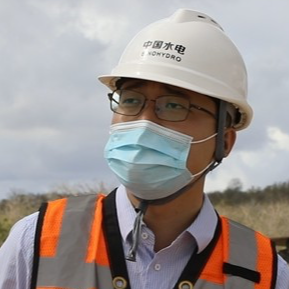Utilizing Hydropower Brings Human Rights to Africa
The Ignored 5 Billion People
I have a question that I often like to ask my friends: what is the most common way of eating in the world? Is it a knife and fork? Chopsticks? Or something else?
The answer is bare hands. There are more than 8 billion people in the world. Of these, only about 3 billion habitually use knives, forks, and chopsticks together. The rest, over 4 billion people, are used to eating with their hands.
This may seem counterintuitive. In the subconscious of many of us, the world is generally divided into “East” and “West”. One of the major differences between the two is whether we use chopsticks or knives and forks. As for the world of eating rice with your hands, it is just a tiny corner of the world, and in the minds of many people, the only function of this “world” may be to provide some amusing content for short video platforms.
But is this really the case? Can the whole of the Middle East, Africa, South Asia, and half of Southeast Asia be so easily dismissed from our knowledge and turned into the “dispensable side of the world”?
Of course not. There are more than 200 countries and regions on our planet. They are home to more than 8 billion people. There are only a few which tend to dominate the international stage and enjoy the spotlight all year round. Those outside the spotlight may have developed later than we have, may have accumulated fewer resources and wealth than we have, and may have little voice in the international arena, but at the intellectual level, they are human beings just like us. All human beings have the initiative and desire to develop, and corresponding actions. Moreover, this population of over 5 billion people in Southeast Asia, South Asia, the Middle East, Africa, and Latin America is the numerical majority of humanity.
If we want to address the issue of “new quality productive forces” on a global scale, we cannot leave them behind. The concept can not be established without their participation.
What is a median African daily life like? From our perspective, this is a life of extreme poverty:
They don’t have any organized agriculture or management and maintenance of arable land. So, their farming is left to God’s mercy, which means they cannot harvest much. Once lacking grain, they eat fruit.
They live in adobe houses with thatched roofs, and in better villages, there are brick houses with tin roofs. Most families do not have furniture other than a blanket for their children to sleep on. In most villages, there are no transportation tools, just walking. Most villages do not have wells, women have to carry a bucket to the nearest river to fetch water, spending most of the time on it every day.
Many of them wear old clothes from abroad, more than half of them do not have access to electricity, and in many households, the only electrical appliance is a cell phone, which they have to take to the stores in the central towns along the highway to recharge.
Most African countries have free healthcare, but free also means no care at all. It is common for hospitals to be unable to offer saline, so when you get sick, you can only rely on God to save you.
 An African slam surrounded by garbage | Source: Getty Images
An African slam surrounded by garbage | Source: Getty Images
Nowadays, there is always a viewpoint in the West that likes to put development and environmental protection in opposition to each other, arguing that environmental pollution is brought about by development. As long as we live a primitive life, we will not cause pollution, and then they have a corollary, that is, if we let the people who live a backward life keep their living situation, then the environment will not be further polluted.
Let’s put aside whether it is ethical for a modern society to let more than half of humans stay in this kind of poverty and misery, and say whether this logic is valid. The reality is exactly the opposite. Environmental protection and development are not mutually antagonistic, but mutually reinforcing. The more primitive and impoverished people’s lives are, the more damage they do to the environment because they have to survive. For example, without modern field management, primitive slash-and-burn farming yields extremely low. Even if dozens of acres of forest are destroyed for farming, the yield of traditional farming methods is only equivalent to the yield of modern agriculture using one acre of land.
People also need energy to live. Without modern sources of energy such as coal and natural gas, people have to use traditional methods like cutting down trees directly and burning them in kilns to make charcoal, which is extremely wasteful.
Even so, when burning coal, thermal power plants with advanced environmental protection facilities not only generate energy efficiently but also handle pollutants properly, emitting only carbon dioxide. Pollutants such as dust, nitride, and sulfide would not be produced. However, pollutants from the burning of loose coal are directly released into the air, which is the reason for the severe pollution in Ulaanbaatar.
However, for residents of city slums, it is not easy to obtain charcoal. Therefore, they found old tires for burning. The heat generated by burning a small piece of old tire can cook a pot of rice. The gases produced by burning tires are highly carcinogenic. In Africa, the smell of burning tires wafts through the cities every evening.
All the above situations in poor regions show that the naive view that a life of primitive poverty can reduce pollution is untenable. In contrast, environmental protection can only be achieved when productivity is enhanced, and the various resources required for human survival are produced efficiently through modernization. It is only when energy can be obtained in a centralized manner that the burning of trees can be avoided to reduce air pollution. Similarly, only when yields are increased through the application of modern agricultural techniques will there be an incentive for individuals and communities to reduce their occupation of forests and the hunting of wild animals.
In addition, poverty leads to low levels of education and high levels of unemployment, all of which push up fertility. According to the United Nations’ World Population Prospects 2019, from 2015 to 2020, the total fertility rates of high-income, upper-middle-income, lower-middle-income, and low-income economies are 1.67, 1.90, 2.71, and 4.52, respectively, with fertility rates rising sequentially with lower incomes. The median fertility rate in developed economies is 1.64, with the average couple having fewer than 2 children, but among the less developed economies, there are 13 countries with fertility rates above 5, which means that their populations could double in 20 years. The Democratic Republic of Congo (DRC), for example, had a total population of more than 100 million in 2023; in 2003 it had a population of only 51 million, and in 1979 it had only 25 million. In less than 20 years, the DRC’s population could top 200 million. In these countries, primitive production methods, paired with exploding populations, have been exponentially more destructive to the natural environment.
 World Population Prospects 2019 | Source: Population Division of the UN
World Population Prospects 2019 | Source: Population Division of the UN
There is another self-evident problem: war. The exponential growth of the population results in a shortage of essential resources, leading to conflicts and even wars over access to these limited resources. War itself is one of the biggest sources of carbon emissions. Many African countries are in a constant state of warlordism, which causes a lot of pollution every day, but does not reduce the fast population growth. What’s more, wars have a devastating effect on the social order, leading to a lack of educational resources and jobs, and resulting in higher fertility rates, which is a vicious circle. At the same time, these populations may flee from their homeland, creating ever-increasing waves of refugees, resulting in wider unrest and greater humanitarian catastrophes.
Against this backdrop, it is impossible to reduce energy consumption and emissions to lower the total global emissions relying on a few developed economies. If we want to build new quality productive forces and take responsibility for human survival on Earth, we must abandon this fantasy. It must be a global effort; otherwise, the goal cannot be achieved.
From this point of view, the developed economies are obliged to assist the less developed countries to modernize faster and more efficiently, transforming primitive production methods into modern ones. Once the infrastructure, such as electricity, is in place, and people are educated, find jobs, and become prosperous, birth rates will decline, and environmental pressures will be alleviated. This will lead to a more positive economic cycle, gradually integrating societies into a modern governance framework. For developed economies, this is largely a form of self-preservation.
Technical Feasibility Analysis of Constructing Clean Energy in Africa
Modernization, especially of clean energy, is feasible in Africa. Hydropower has a number of advantages over other forms of energy. Apart from a relatively large investment in the early construction stages, it has a low marginal cost of power generation later, which only requires water from upstream.
Electricity is difficult to store, but water can be easily stored in reservoirs. It is more flexible than other power generation methods, as more units are turned on for peak electricity consumption and less for low valleys. What’s more, in addition to power generation, hydropower stations also serve functions such as flood control and irrigation, which helps people’s livelihoods in the basin tremendously. Although problems always appear in real operation, scientifically constructed hydropower plants are clean energy sources whose benefits far outweigh shortcomings.
Africa is extremely rich in hydropower resources, with resource reserves amounting to 1.155 million megawatts (MW), which is 34 times the current total installed capacity of 34,000 MW of hydropower in the whole of Africa. The hydroelectric resources on the Congo River alone, if fully utilized, could meet the electricity needs of the whole of Africa. Since existing hydroelectric resources have not yet been fully exploited, we can build first where it will be most profitable.
Hydroelectric power plants are generally large. The energy construction of African countries is in its infancy, so a single hydroelectric power plant can often make a significant increase in the power supply of the whole country.
Take the Tanzanian Julius Nyerere Hydropower Project we are involved in as an example. Once completed, it can double the country’s electricity supply, effectively solving the severe power shortage problem. This will make the operation of various industrial facilities smoother and significantly reduce losses caused by power outages. The surplus electricity will create new opportunities for industrial investment, allowing Tanzania to develop its electricity-dependent industries without power shortages over the next five years while constructing other power plants. New industrial investments will create more jobs and generate more tax revenue for Tanzania. Additionally, the hydropower plant itself will bring substantial income. This way, a positive economic cycle can gradually be established.
 the Tanzanian Julius Nyerere Hydropower Project | Source: Tanzania Invest
the Tanzanian Julius Nyerere Hydropower Project | Source: Tanzania Invest
It can be said that there are no technical challenges to clean energy construction in Africa, and all the obstacles are outside of technology. At present, most African countries are not as smooth as Tanzania in energy construction, and investors in general do not have enough confidence in the prospects for future development in Africa. We know that African countries have a very weak industrial base, a shortage of high-quality labor, a lack of domestic capital, a relatively primitive social structure, and governments plagued by uncontrollable corruption. These factors make development and construction difficult, restrict investment, and lower economic efficiency. In addition, many African countries are often politically unstable, so the security of investment is not guaranteed. Carrying out large-scale power construction requires a large investment of both money and time, the above factors lead to too many variables. These are indeed more realistic problems.
In fact, the predicament faced by the third world countries as a whole is similar to that of Africa, in that they are all hampered in their development by various social conflicts, which prevent societies from entering into a virtuous cycle and perpetuate poverty, and accordingly, new quality productive forces cannot be developed.
Many people might infer pessimistically that the so-called new quality productive forces should be a concept at a higher level than productivity. Given that these less developed economies stuck in a vicious cycle find it challenging to develop even basic productivity, is it too early to talk about new quality productive forces? In fact, the situation is not that pessimistic. The reason for holding such a view is essentially due to subconsciously opposing environmental protection and development.
For example, with the rapid iteration of technology, the cost of solar photovoltaic (PV) power generation is also decreasing sharply. Especially in tropical regions like Africa, where sunlight is abundant, the cost of PV power generation is not much higher than that of traditional thermal power plants, and its performance is becoming increasingly stable. Compared to traditional energy sources, PV panel’s deployment is highly flexible. Once produced, they are easy to install and adjust according to different demands. This makes PV power stations particularly suitable for scenarios such as distributed power grids.
 PV panels deployed on the rooftops of primitive African dwellings | Source: CCTV News Africa
PV panels deployed on the rooftops of primitive African dwellings | Source: CCTV News Africa
To connect a remote village to the national power grid is too costly and unprofitable in the short term. However, a small PV power station, combined with some wind power and energy storage facilities, can be set up to supply power to that village. This way, we can first address the issue of accessibility, ensuring that people have electricity. Once there is sufficient funding, we can gradually improve the quality. These small, distributed power grids are developing rapidly and are quite practical in many remote areas of Africa.
 An African villager who get electricity through solar PV panel | Source:IC Photo
An African villager who get electricity through solar PV panel | Source:IC Photo
What Caused Inequalities in Global Energy Supply?
The current global inequality in energy supply is partly due to the nature of fossil fuels. Fossil fuels are non-renewable resources with extremely unbalanced geographical distribution and exclusive usage—you use it, I don’t have it. Developed countries, through economic and military means, can always secure access to these resources ahead of developing countries. Today’s developed economies are either producers of fossil fuels, can control global fossil fuel extraction, or at least can profit excessively by being part of this system.
One significant characteristic of clean energy is its local accessibility. For instance, sunlight is available everywhere and can be converted into electricity and fed directly into the grid, making it relatively non-exclusive. It is estimated that the global reserves of clean energy exceed 450 trillion tons of standard coal, which is 38 times the reserves of fossil fuels. If these energy sources can be fully exploited, developing countries can avoid zero-sum energy conflicts with developed countries. From this perspective, the energy transition not only helps protect the ecological environment but also provides fair development opportunities for all countries.
Of course, the Third World, represented by Africa, objectively faces many obstacles in development that cannot be resolved in the short term. Therefore, if the goal is to build new quality productive forces on a global scale, we cannot expect to achieve it at once. We must respect objective laws and implement gradual reforms. If close ties could be established between China and the Third World to help them gradually build new, eco-friendly development models, it will not only contribute to the long-term survival of humanity but also benefit China in return.
What Makes China’s New Quality Productive Forces Different from the West’s?
Today, China indeed directly possesses new quality productive forces on the material level. Chinese companies almost control the entire industrial chain of new energy, from research and development to production, sales, and transportation, allowing them to easily provide comprehensive solutions.
From 2010 to 2020, Chinese companies participated in the construction of approximately 150 power plants and transmission and distribution projects in Africa. Over 100 million people in Africa gained access to electricity through the electricity grid, with Chinese companies contributing to 30% of this, which is about 30 million people. By the end of 2024, China will complete 49 power generation projects in Africa, most of which are renewable energy projects, accounting for 20% of the total installed capacity in the region during the same period. Honestly speaking, China has played an important role in global energy equity and even productivity equity. Without Western countries, China can still lead Third World countries in building new quality productive forces. However, without China, it may be difficult for the West to achieve significant progress in this area.
Of course, compared to the West, China also has disadvantages, particularly in terms of discourse power. Due to the long investment cycle for new energy infrastructure, though Chinese companies are doing the most tiring work and earning relatively low profits, it’s difficult for them to establish brand effect and market recognition in the short term. The perception of local people is still dominated by the Western discourse. Even a little smearing by Western capital-manipulated media and NGOs can put Chinese companies in a very passive position, making it difficult for them to defend and counteract.
Since the colonial era, Western powers have been deeply rooted in the Third World such as Africa, the Middle East, South Asia, Southeast Asia, and Latin America. Their influence is deeply entrenched which China can not follow up in the short term. China needs to be patient and gradually establish roots in the target countries, cultivate a localized talent base, build brand recognition, and gain acceptance in the local market. Gradually, this will help China establish its discourse power. This process may require the efforts of one or two generations to achieve.
But in any case, the construction of new quality productive forces is a key chance for less developed countries to achieve development and enter a virtuous cycle. In the era of new quality productive forces, enjoying modern life is no longer a privilege of the rich nations but should be a basic human right that all humanity inherently deserves. Ethically, our Earth should belong to all 8 billion people, not just 3 billion. Rationally, a human society where 8 billion people contribute their wisdom together will undoubtedly advance further.




